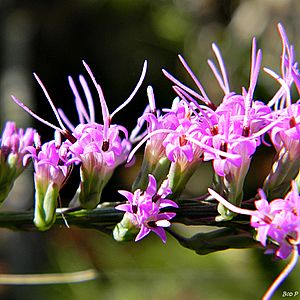Chapman's blazing star facts for kids
Quick facts for kids Chapman's blazing star |
|
|---|---|
 |
|
| Scientific classification |
Liatris chapmanii, often called Chapman's blazing star or Chapman's gayfeather, is a beautiful plant. It belongs to the Asteraceae family, which is also known as the aster or daisy family. This plant is part of the Liatris group.
You can find Chapman's blazing star growing naturally in the southeastern United States. It lives in states like Alabama, Florida, and Georgia. This plant is quite adaptable and grows in many different places. It likes sandy areas such as dunes, beach strands, and sand ridges. You might also spot it in open fields, along roadsides, or in special forests called longleaf pine savannas. It also thrives in other scrubby, dry habitats.
What Does Chapman's Blazing Star Look Like?
Chapman's blazing star grows from a special underground part called a corm. A corm is like a rounded or long bulb. From these corms, the plant sends up tall stems. These stems usually grow about 35 to 75 centimeters (14 to 30 inches) high. Sometimes, they can even reach up to 150 centimeters (59 inches) tall! The stems often have short, ridged hairs.
Its Unique Flowers and Leaves
This plant has flowers that grow in dense clusters called heads. These heads are pressed close against the stems. They don't have individual stalks, but instead, they form a thick, spike-like collection of blooms.
The leaves of Chapman's blazing star are also interesting. The leaves at the bottom of the plant and along the stem are shaped like a spoon or a narrow spear. They have just one main vein. You might notice tiny dots on the leaves, which are glands. The leaves can be smooth or have short, stiff hairs.
When Does It Bloom?
Chapman's blazing star puts on a show of its beautiful flowers in late summer and early fall. You can usually see it blooming between August and October. After the flowers fade, the plant produces its seeds. These seeds are found in small fruits called cypselae. Each cypsela is about 4 to 6 millimeters long. They have feathery, bristle-like tops that help them float in the wind. These feathery parts have tiny barbs, like miniature hooks.

